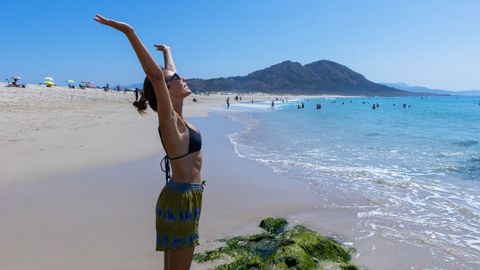
These beaches have been highlighted by international media, and their fame has crossed borders to the point of being recognized as some of the best in the world
12 nov 2025 . Actualizado a las 17:49 h.They are the most acclaimed and can boast of being objects of international admiration. Their surroundings, beauty, and paradisiacal waters have led several foreign media outlets to recognize them as some of the best beaches in Spain… and in the world.
1. Rodas Beach, Cíes Islands (Vigo)
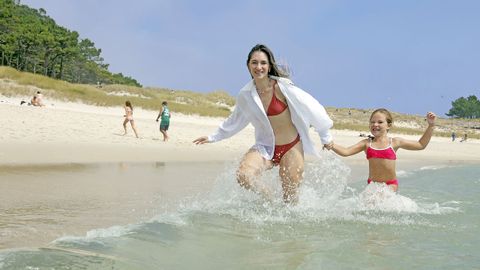
If there is one Galician beach recognized worldwide, it is Rodas. The jewel of the Cíes Islands, also featured on this magazine’s cover, has once again been included this year in Condé Nast Traveler’s list of the best beaches in Galicia, but its fame crosses borders. The Telegraph ranks it among the 40 best beaches in Europe, and it is the only Spanish beach among the 50 best in the world according to The Worlds 50 Best Beaches. It all began in 2007 with recognition from The Guardian, which named it the best beach in the world. An authentic international endorsement for this paradisiacal sand spit shaped like a crescent of white sand and crystal-clear waters, separating Monteagudo and Faro islands, reachable in less than an hour by boat from Vigo, Baiona, or Cangas. Its high demand has led tickets to sell out for August visits for those without prior reservations. During the regular tourist season, the beach has nearby public services, emergency facilities, restaurants, and a campsite for staying several days in the Cíes.
2. Xilloi Beach, O Vicedo (A Mariña)

In O Vicedo, a rising star among the trendy destinations of the Rías Altas thanks to its beaches, lies Xilloi, one of the most popular spots in the Mariña Lucense. “This semi-urban beach on the Lugo coast is a natural beauty of dunes, reeds, cliffs, and fine white sand. One kilometer in length — actually 550 meters — of sheltered sand perfect for a day at the beach,” notes National Geographic, which highlights its views of the port of Bares and its recreational area with full services. Its travel section named it one of the best beaches in Spain, and last year it was a finalist in the ranking of the country’s top beach destinations, along with Costa Brava, Fuerteventura, and the Asturian Green Coast, in a contest won by Menorca, which highlighted the Lugo “Caribbean” as a perfect place to unwind without crowds. “A peaceful beach that quickly becomes a favorite of all who visit,” says Condé Nast Traveler. Shaped like a shell, it is sheltered from the wind, resulting in calm waters — a natural paradise with parking facilities.
3. As Catedrais, Ribadeo (A Mariña)
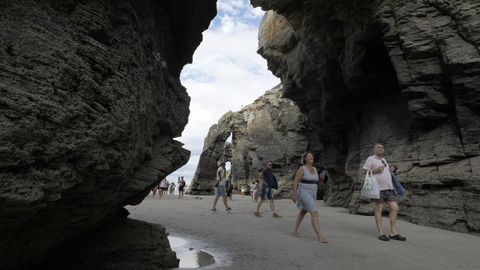
The German travel comparison and booking site Omio selected Galicia’s largest natural monument this summer as the best beach in Spain in its latest ranking, based on reviews from online travel platforms. The average rating from all sources gave As Catedrais the highest score. In recent years, the beach has already appeared among the best in Europe and the most unique worldwide, in addition to being the main tourist magnet of the Mariña Lucense. The Times recommends it as a must-see stop in the Rías Altas, and The Telegraph praised it this summer as one of the 40 best beaches in Europe, highlighting Rodas as one of six Spanish beaches on the list. “It can be visited, but be sure to book entry authorization well in advance during summer and Easter, as it usually sells out and is the only way to access it,” warns Traveler, noting that although “it’s not the best beach for swimming,” it is “essential for being a natural monument.” It is described as “the perfect spot to end a coastal route along Galicia before reaching Asturias,” where visitors go “to stroll among its stone arches at low tide.” More than 300,000 people visit this monument each summer, making it the most visited site in Galicia after Santiago Cathedral.
4. A Frouxeira Beach, Valdoviño (Ferrol)
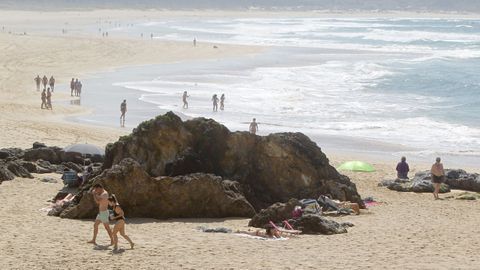
Another increasingly popular destination on Galicia’s northern coast is Valdoviño. HomeToGo, the platform with the largest selection of vacation homes and rentals in the world, ranks it seventh among Europe’s 50 hidden gems for this summer, based on highly rated and less crowded locations. The portal describes it as: “Wild cliffs, pristine beaches, and Atlantic spirit.” Only six other destinations in Portugal, Italy, Greece, France, and Germany rank above it. Among its main attractions is A Frouxeira Beach, nicknamed the Malibu of Ferrolterra for its characteristic palm trees. The lagoon of the same name empties here, and local legend speaks of its healing waters. It was also included in National Geographic’s list of the 14 best beaches in Galicia last summer. Additionally, Traveler highlights Pantín Beach, famous for its annual championship bringing together the world’s best surfers. Doniños Beach is also mentioned by The Times among the most attractive Rías Altas destinations, while Viajar praises Fornos Beach in Cariño.
5. Area de Secada, A Illa de Arousa (Pontevedra)
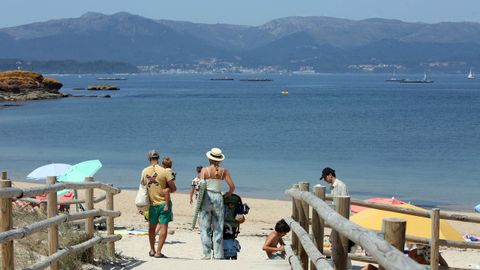
In the municipality with the most beaches in Galicia — 64 in total — one of the highlights is Area de Secada. Walking through the dense pine forest that leads to it, visitors encounter fine sand, rock formations that divide it into different areas, and a perfectly calm sea. Spending the day here allows for meals at the beach bar or enjoying a homemade lunch under the shade of trees. With Blue Flag status, it stretches about 420 meters and has a mobile dune flanked by native vegetation that is protected. Lifeguards, bathrooms, showers, pedal boats, and parking are available. Condé Nast Traveler highlighted it this summer, noting that although “the beaches of A Illa, with their seaweed, flints, and pinewoods, probably cannot compare with their neighbors on the other side of the ria, in A Coruña province, no trip to the Rías Baixas is complete without visiting it.” The surroundings are ideal for cycling, local cuisine in the port is excellent, and the sunset at Punta Cabalo is spectacular.
Únete a nuestro canal de WhatsApp
6. Vidreiro Beach, O Vicedo (A Mariña)
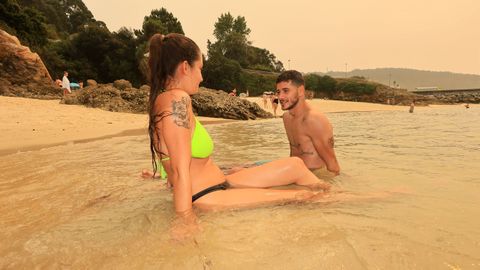
“The secret beach of Galicia that looks like it came from the Caribbean.” Specialized media describe this summer’s hidden gem, again near the port of O Vicedo — a truly concealed treasure along the Galician coast, so hidden that even locals may not know it. Very close to Estaca de Bares, it is a tiny beach under 200 meters, with fine white sand — appearing yellowish due to haze — and turquoise, paradisiacal waters. Ideal for escaping crowds, the beach is protected by the O Vicedo port breakwater, keeping the water calm and perfect for children. Surrounded by lush vegetation, it offers privileged views of the O Barqueiro ria. There is nearby parking, and it follows O Caolín Beach, famous for its extremely white sand, rich in kaolin used for ceramics — hence many publications called it “porcelain beach.” Vidreiro is similar but less crowded. Continuing along the Mariña coast, in Viveiro, Covas Beach has also been mentioned for its beauty by National Geographic and Traveler, which additionally highlight Llas Beach in Foz.
7. Melide Beach, Ons Island (Pontevedra)
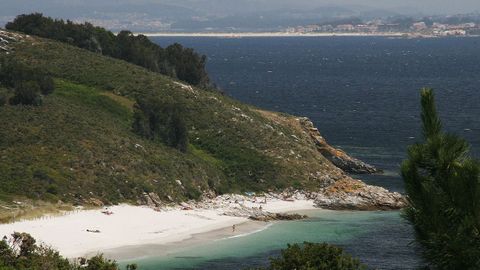
One of the island’s most popular beaches, Melide has caught the eye of National Geographic for its beauty. Although it shares a name with the famous Cangas beach overlooking the Cíes, it is Melide on Ons that is in the spotlight this year. “Access requires walking from the dock where the boat lands. It is sheltered from the wind and offers fantastic views over the Pontevedra ria,” notes the publication, which adds that in summer “boats depart from Portonovo, Cangas, Sanxenxo, Aldán, Marín, and Bueu.” Walking to the beach is worthwhile, according to Traveler, which calls it a “virgin sand stretch dotted with rocks.” Its golden sand and waters complete a stunning landscape, crowning it as the jewel of the island. Surrounded by pines, it attracts visitors for its peaceful atmosphere and nudist tradition. The Rías Baixas were also chosen as the best beach destination in Spain, ahead of Cabo de Gata, Costa Brava, Gran Canaria, and Cantabria’s Western Coast. Additionally, A Lanzada (Sanxenxo and O Grove), Ladeira (Baiona), O Vao (Coruxo), Playa América and Patos (Nigrán), and Nerga, Viñó, and Barra (Cangas do Morrazo) are among Galicia’s best.
8. Area Maior, Louro (Muros)

Without detracting from Carnota Beach, the longest and one of Galicia’s most international, National Geographic highlights nearby Area Maior in its selection of the most beautiful Galician beaches. This 1.5 km virgin beach, ending at Ancoradoiro, features white sand, strong waves, and wind, standing out for its spectacular scenery, particularly the Louro mountain and lagoon. It is one of the main tourist attractions of the Costa da Morte and a prime spot for surfers. Area Maior often has a beach bar during summer and offers a cinematic sunset. National Geographic describes it as one of Galicia’s “most spectacular and best-preserved beaches,” with a landscape “hard to find elsewhere.” The beach “encloses the As Xarfas lagoon” and is complemented by Monte Louro at the entrance to the Muros and Noia ria, whose “curved silhouette and natural reserve accompany swimmers.” Dolphins can sometimes be spotted, depending on the season.
9. Mar de Fóra Beach, Fisterra (A Coruña)
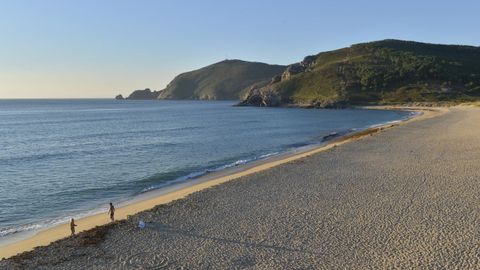
The Los Angeles Times notes this beach, highlighting the cliffs along its edge and the underwater currents “that have swept away countless swimmers.” Indeed, this beach, recognized this summer by the American press as one of Galicia’s most beautiful, can be dangerous for swimming, so it is better to stay out of the water. However, it is also the Galician beach where the sun sets latest, making it perfect for sunsets and views. “You can feel the ocean roar here,” says the travel section of National Geographic, noting it has become “one of the most beautiful postcards of the area, especially at sunset.” Accessible via a boardwalk or a small section of the Camiño dos Faros, Baldaio Beach is also highlighted by Viajar as one of Galicia’s most beautiful, notable for its stunning coastline and special environmental protection: “The mix of freshwater rivers flowing through and the sea makes it teeming with life and an excellent birdwatching spot.” It is considered “perfect for swimming or walking along its four-kilometer stretch.”
10. Riazor and Orzán, A Coruña
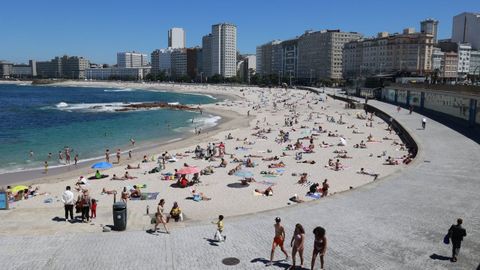
The urban beach shaping A Coruña’s coastline with its characteristic shell form — the second-longest promenade in Europe at 13 km — ranks, according to the British press via National Geographic, among Spain’s eight best urban beaches. Riazor and Orzán occupy seventh place: “A Coruña’s main beach actually consists of two sandy areas: Riazor and Orzán, nestled in a small Atlantic cove northwest of the city center.” “It is the hub of a lively local surf scene, but also an arts center and a culinary hotspot for seafood,” the publication continues, mentioning the Picasso House Museum and the Museum of Fine Arts, suggesting visitors can walk north along the coast to the Tower of Hercules. The beach has Blue Flag status, coarse sand, is suitable for all water sports, and experiences moderate waves with steady winds.